The Smith Machine calf raise is a machine-based exercise that targets the muscles of the calves, particularly the gastrocnemius, with supporting muscles including the soleus and tibialis anterior.
It is not your average calf exercise. The Smith machine stabilizes the bar, allowing you to focus solely on your calf’s movement. This setup allows you to lift heavier weights with better form, which can lead to greater muscle growth.
It is a good way to make your lower legs look bigger and thicker than just doing regular bodyweight calf raises. It also helps improve lower body strength and stability and athletic performance.
There are different ways to do Smith machine calf raises, such as one-leg calf raises, standing calf raises, and seated calf raises.
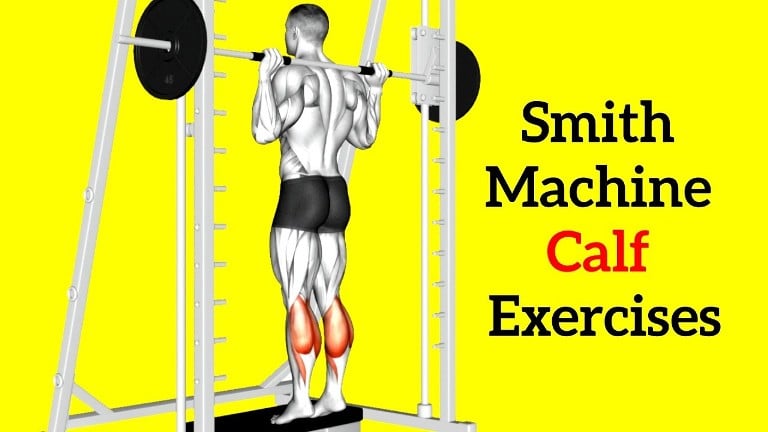
- Smith Machine Calf Raise Muscles Worked
- 1. Primarily Muscle Worked
- 2. Secondary Muscles Worked
- 3. Supporting and Stabilizing Muscles
- How To Do Calf Raise On Smith Machine
- Tips and Form
- Smith Machine Calf Raise Variations
- 1. Single Leg Standing Smith Machine Calf Raise
- 2. Seated Machine Calf Raise
- FAQs
- Is the Smith machine good for calf raises?
- How many reps for Smith machine calf raises?
- Conclusion
Smith Machine Calf Raise Muscles Worked
Calf raises target several muscles in the lower leg.
1. Primarily Muscle Worked
- Gastrocnemius: Large diamond-shaped muscle that forms the bulk of the visible calf muscle. The gastrocnemius is worked in knee-extended calf raises.
- Soleus: This is the smaller, flat muscle located underneath the gastrocnemius. The soleus is better isolated in seated calf raises with the knees bent.
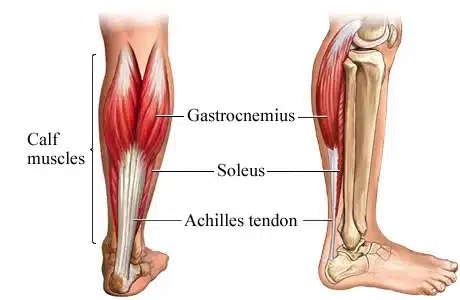
2. Secondary Muscles Worked
- Tibialis posterior: This lies deep within the calf. It assists with plantarflexion of the ankle.
- Peroneals: These are the smaller lateral calf muscles that run along the outside of the lower leg. They aid in stabilization during calf raises.
- Flexor hallucis longus: Deeper muscle that helps flex the big toe. It contributes minimally during the movement.
3. Supporting and Stabilizing Muscles
- Glutes: Help extend the hips and stabilize the torso.
- Hamstrings: Act isometrically to stabilize the knee joint.
- Lower back: maintain an upright posture.
Know More: 20 Best Calf Exercises And Workout For Building Bigger Calves
How To Do Calf Raise On Smith Machine
- Adjust the Smith Machine’s barbell to approximately shoulder height. Make sure the safety catches or pins are properly set.
- Add the appropriate amount of weight to the barbell. If you’re new to this exercise, start with a lighter weight to focus on form.
- Step under the barbell so it rests on your upper traps and shoulders.
- Place your feet shoulder-width apart and parallel to each other. If possible, stand on a raised platform or calf block with the balls of your feet on the surface and heels hanging off.
- Grasp the bar with a wide grip and place it across the top of your trapezius muscles (not the bones of your spine).
- Tighten your core muscles for stability.
- Press down through the balls of both feet, lifting your body upwards.
- Elevate your heels as high as possible, fully extending your ankles and flexing your calf muscles at the top.
- Contract your calf muscles, then slowly lower your heels back to the starting position.
- Repeat the movement until you have completed the desired number of repetitions, i.e 12-20.
Related Post: 12 Most Effective Smith Machine Leg Workout & Exercises
Tips and Form
Performing Smith Machine Calf Raises may seem straightforward, but several common errors can hinder your progress or even lead to injury. Below are some mistakes to watch out for and tips on how to avoid them.
- Do not let your heels touch the floor during the entire set.
- Keep your feet parallel and shoulder-width apart. Feet too close together, too far apart, or not parallel can reduce exercise effectiveness and cause strain.
- Position the bar comfortably across your upper traps, not too high or low. This prevents unnecessary strain on your shoulders and neck.
- Keep a steady pace and focus on muscle contraction and stretch in each workout phase. Performing the exercise too quickly can lead to sloppy form and reduced muscle engagement.
- Don’t sacrifice contraction for the sake of adding plates. Start with a manageable weight and focus on technique. Only add weight when it’s necessary.
- When doing a Smith machine calf raise, keep your back straight. Leaning forward can stress your lower back.
- The balls of your feet should be right on the edge of the block. Do not allow them to come forward, as it makes the exercise less challenging.
- Perform both the upward and downward phases of the calf, and raise slowly and deliberately.
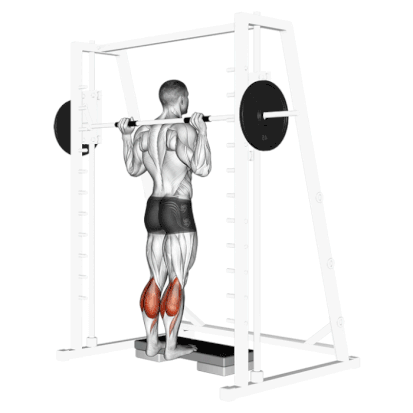
Smith Machine Calf Raise Variations
Here are some variations and progressions of the Smith Machine Calf Raise:
1. Single Leg Standing Smith Machine Calf Raise
It is a challenging and more advanced version of the standard Smith machine calf raise. A one-leg machine calf raise is a very effective isolation exercise targeting gastrocnemius.
You can do the one-leg calf raise on the floor if you don’t have a platform to do the exercise.
- It focuses on individual calf muscles, which can help address muscle imbalances.
- Increases muscle activation due to the greater load on a single calf.
- Allows for more concentrated effort and potentially faster progression
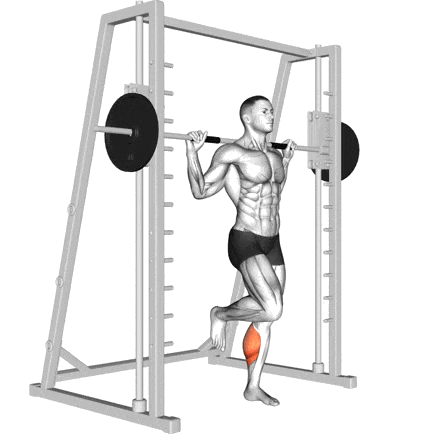
How To Do
- Position yourself with one foot flat on the floor or on a calf block.
- Stand upright and hold the bar with an overhand grip slightly wider than shoulder-width apart.
- Hold the barbell with a grip that’s wider than shoulder-width.
- Lift one leg off the floor and either bend at the knee, crossing it behind the standing leg, or hold it in the air.
- Raise your heel as high as possible.
- Lower your heel back down to the starting position.
- Repeat for the desired number of reps and then switch legs.
2. Seated Machine Calf Raise
Another popular calf exercise is the seated Smith machine calf raise. It emphasizes the soleus muscle of the calf. In the seated calf raise, your soleus is the target muscle, and your gastrocnemius is the synergy muscle.
Since the soleus comprises slow-twitch muscle fibers, performing the seated calf raise builds the endurance required for running, cycling, and walking.
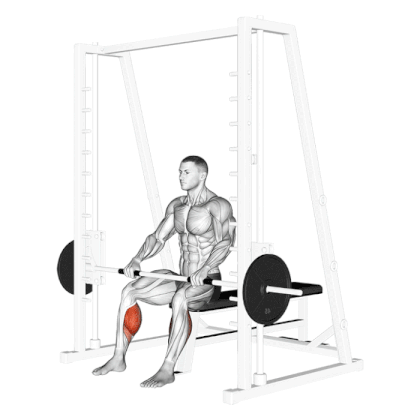
How To Do
- Place a flat bench near the Smith machine and put a step or calf block under the bar
- Sit on the bench and place the balls of your feet on the floor or step or calf block.
- Place toes straightforward, knees bent at 90 degrees, feet shoulder-width apart.
- Keep hands on the bar for support, but use a light grip.
- Raise your heels up as high as possible and squeeze your calves at the top.
- Slowly lower your heels back down to the starting position.
FAQs
Is the Smith machine good for calf raises?
Yes, the Smith machine is good for calf raises. It allows you to isolate the calves and maximize calf activation. The fixed bar path allows you to use heavier weights than free-weight calf raises safely.
How many reps for Smith machine calf raises?
- For hypertrophy, do 8–12 reps.
- For endurance, do 15-20+ reps.
- Going heavier in the 6-8 rep range can help you build more strength and grow stronger.
Conclusion
The Smith Machine can be used for standing calf raises or the specialized seated calf raise machine. Each version has its unique benefits and focus.
- Standing Smith Machine Calf Raises primarily target the gastrocnemius muscle. It offers variations like single-leg raises.
- Seated Machine Calf Raises are excellent for isolating the soleus muscle.
I strongly suggest that you incorporate them into your workout regimen to achieve stronger and more sculpted calves.

Manish is a NASM-certified fitness and nutrition coach with over 10 years of experience in weight lifting and fat loss fitness coaching. He specializes in gym-based training and has a lot of knowledge about exercise, lifting technique, biomechanics, and more.
Through “Fit Life Regime,” he generously shares the insights he’s gained over a decade in the field. His goal is to equip others with the knowledge to start their own fitness journey.
